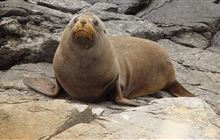Seals need rest not rescuing
Archived content: This media release was accurate on the date of publication.
Introduction
Concerned members of the public can rest assured seals on Whanganui beaches are just there for a rest.Date: 18 July 2018
Concerned members of the public can rest assured seals on Whanganui beaches are just there for a rest.
It’s that time of the year when our beloved NZ fur seals/kekeno turn up in all sorts of strange and wonderful places.
Mums leave their pups for short periods to feed, and pups may go exploring during this time.
Inquisitive seals have been known to travel as far as 10 kilometres inland, up streams.
Newly-weaned fur seal pups and juveniles also come ashore, but it’s just a resting up period for them before they head out to sea again in search of food.
Department of Conservation Whanganui Biodiversity Ranger Sara Treadgold says seals usually arrive between August and November, but they have turned up as early as June. So be aware and mindful when walking along Castlecliff, Kaiiwi and South Beach.
The seals may look distressed and scrawny, display signs of sneezing or coughing and may have weepy eyes, but it’s just natural for them, and they really don’t need any human help. They will return to the water and swim away when they are rested and ready to go, Sara says.
Sara’s advice is even if a seal looks injured, leave them alone. Seals are capable and resilient and given time and space, they usually find their way home.
While seals may look harmless and helpless they are wild animals and will defend themselves if they feel threatened. They can carry infectious diseases and can cause serious injuries.
“It’s important to keep dogs away from seals. If a dog makes direct contact with a seal, there is a potential for the dog to pass on diseases.
“You may also encounter other seal species including the Leopard seal. Leopard seals are very large animals. They could easily crush a person simply by rolling over and can move surprisingly quickly on land. Although they have fairly small teeth, they are capable of penetrating another seal's skin and can inflict a serious wound to humans,” Sara says.
DOC has a hands-off policy with seals and will only intervene if a seal is obviously severely injured, is entangled in marine debris or is in a dangerous place such as on or near a public road. In that case, people could call the 24-hour hotline 0800 DOC HOT (0800 362 468).
If you encounter a seal on or near a beach, please leave it to rest.
- Always keep dogs on a leash, under control and away from seals
- Ensure you keep small children at a safe distance and under your control when watching seals
- Avoid getting closer than 20 metres
- Do not get between the seal and the sea
- Do not touch or feed the seal
Seals are protected under the Marine Mammals Protection Act.
If you see a seal that’s in serious trouble
Is it in danger? Call 0800 DOC HOT
If you come across a seal that you think is in danger, the best thing to do is call 0800 DOC HOT. The Department of Conservation has people trained in marine mammal response who can determine what the best course of action is.
Never attempt to handle a seal yourself or move it from its location
They are wild animals and while they may look cute and cuddly they can be very aggressive when threatened. Stay at least 20 metres away. Handling can also be very stressful for the animal and moving very young pups away from where the mother has left them makes it very difficult for them to reunite. If you are worried about the seal, please take a photo from a safe distance and call 0800 DOC HOT.
Someone once picked up a young pup from a South Island shore and took it on the ferry to a vet in the North Island. Sadly, this animal had to be put down because it was too young to survive on its own and its mother would never be able to reunite with it.
If you’re unsure, call DOC
In New Zealand we are so lucky to have passionate and caring people who want to help our wildlife in any way they can. If you come across a seal in a strange place, ask yourself:
- is the seal away from a waterway where it might find its way back to the sea?
- is the seal injured or in immediate danger?
- is it being harassed by people, dogs or something else?
If you answered yes to these questions then please call 0800 DOC HOT,
Background information
New Zealand fur seals once lived and bred right round the coast of New Zealand. But they were hunted for more than 700 years.
An estimated two million New Zealand fur seals were clubbed to death in the early 1800s to make fur seal hats and coats. Oil from their bodies was also burned in lamps for lighting.
By the 1830s, the New Zealand fur seal was close to extinction. Sealing was finally banned in 1894. Since then their numbers have been rising and gradually fur seals have been re-colonising our coastline.
In 1991, almost 100 years after sealing was banned, New Zealand fur seals began breeding again at Cape Palliser, at the very bottom of the North Island. Since then fur seals have also been gradually recolonising the North Island coast.
Contact
Sara Treadgold, Biodiversity Ranger, Whanganui
Phone: +64 6 3492100
Email: streadgold@doc.govt.nz

